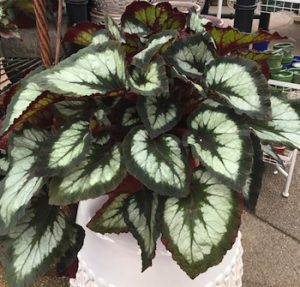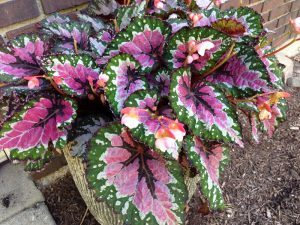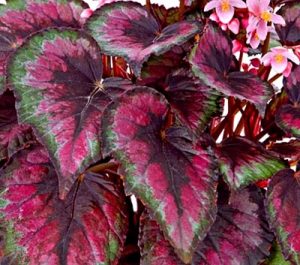Rex Begonia: A New Look at an Old Favorite
By Elizabeth Cornell Fake, Fairfax Master Gardener
 Whenever you hear the word Begonia, your first association is with the Wax Begonia (Begonia semperflorens), which is the workhorse of the home or industrial landscape. Then there is the Tuberous Begonia (Begonia tuberhybrida) with its prolific double blossoms and varied, subtle colors. For those who love drama, there is the Dragon Wing Begonia (Begonia aconitifolia) which is an elegant, showy garden addition with its bold red or hot pink flowers and large shiny green, wing-shaped leaves.
Whenever you hear the word Begonia, your first association is with the Wax Begonia (Begonia semperflorens), which is the workhorse of the home or industrial landscape. Then there is the Tuberous Begonia (Begonia tuberhybrida) with its prolific double blossoms and varied, subtle colors. For those who love drama, there is the Dragon Wing Begonia (Begonia aconitifolia) which is an elegant, showy garden addition with its bold red or hot pink flowers and large shiny green, wing-shaped leaves.
Among the 1,300 species in the Begonia family, there is an outlier that receives little attention but is worthy of consideration, the Begonia rex. It is very different than its cousins, which makes you wonder why it is in the same family, Begoniaceae. Often called the Painted Begonia, it is a rhizomatous species that features elegant, variegated foliage in a wide variety of leaf shapes and numerous color combinations. The Rex Begonia has flowers, but the blossoms are small, unobtrusive and almost invisible among the vibrant foliage. Clumped together, Rex Begonias add texture and contrast to garden beds. But, their best use is as a component of a hanging basket or container. At the end of the growing season, since they are not perennials, they can be overwintered inside as a companionable houseplant.
 Rex Begonias can be grown from seed, planted as nursery seedlings or propagated from a leaf cutting. The seeds are infinitesimally small and visible only under a microscope. Since the seeds are hard to handle, it is best to start a new plant from a seedling or cutting. At most nurseries, you will find them in the houseplant department where you can locate a specimen to get started.
Rex Begonias can be grown from seed, planted as nursery seedlings or propagated from a leaf cutting. The seeds are infinitesimally small and visible only under a microscope. Since the seeds are hard to handle, it is best to start a new plant from a seedling or cutting. At most nurseries, you will find them in the houseplant department where you can locate a specimen to get started.
Other than basic gardening care, Rex Begonias thrive with little attention. Whether planted in the ground or in a container, they need bright but indirect light. Plan for partial sun for 4 to 6 hours per day and well-drained soil. If you are using a container, select a specialized container soil from a nursery or garden center and make sure the container has adequate drainage in the bottom.  Although Rex Begonias prosper in a humid environment, water only as needed and avoid overwatering to prevent root rot. Measure dryness by inserting a finger 1 inch deep in the soil. If the soil is damp, pass up the watering can for that day. Water at the base of the plant and avoid getting the leaves wet to prevent a common malady — powdery mildew. To keep plants from becoming scraggly, prune at the end of the growing season by cutting the top layer of leaves.
Although Rex Begonias prosper in a humid environment, water only as needed and avoid overwatering to prevent root rot. Measure dryness by inserting a finger 1 inch deep in the soil. If the soil is damp, pass up the watering can for that day. Water at the base of the plant and avoid getting the leaves wet to prevent a common malady — powdery mildew. To keep plants from becoming scraggly, prune at the end of the growing season by cutting the top layer of leaves.
A word of caution: the plant is extremely poisonous to most pets and livestock. However, the most toxic parts of the plant are underground. For this reason, Rex Begonias can still be a good choice for garden or home. Enjoy this unique and beautiful member of the Begonia family.
References
Rex Begonia, Gardener’s Corner, University of Illinois Extension
Begonias, Gardening Solutions, University of Florida IFAS
Rex Begonia Seeds, Home Guides, SF Gate